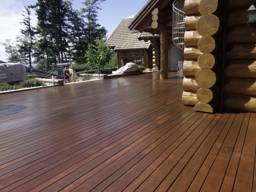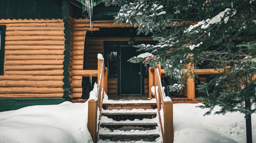
Photos by Perma-Chink
Time — or the lack of it — can cause bad things to happen to good log homes.
I admit to walking around my house, doing tasks, like mowing the lawn, when I happen to spy plants growing out of my gutter or a check that has formed in a log that needs attention. Often, I make a mental note to do something about it next weekend, but in the meantime, the fish start biting or something comes up at work, and poof — my mental note is erased and my log home goes untended.
Am I a procrastinator? Not really. I’m just busy doing other things instead of the things I should be doing, like looking after my home. But all houses — not just log homes — require maintenance; and if you don’t make time for simple upkeep, you’ll find yourself with a much bigger and more expensive repair down the line. In the case of log homes, this typically translates to rot.
As a log home professional, I can tell you that every time I have looked at a rotten log, I can connect the issue to one of the three causes outlined below. But more important than knowing the root of the problem is knowing how to avoid it, or, if it’s too late for avoidance, fix it for good.
See also Preparing for Log Home Spring Maintenance
Here are my big three:
The cause: Non-functioning gutters
Non-functioning gutters (or the lack of gutters altogether) causes nearly $1 billion worth of residential damage every year. Having clogged gutters during a rainfall with just an inch of water accumulation can cause the equivalent of a full season’s worth of rain to stream down your log walls.How to avoid damage: Gutters clog. It’s a fact. The first sign of a clogged gutter is streaking on the visible face of the gutter caused by water spilling over the top. Also, a discoloration of the soffit material due to water overflowing on the back side of the gutters is an indication there’s a problem.
Clean them twice a year (spring and late fall) or install gutter guards (a perforated covering that allows water through, but blocks large debris). Even with gutter guards, you should still inspect once a year to ensure they’re doing their job.
Plus, pay close attention to the north side of your house. It receives less sunlight and logs take longer to dry after it rains.
How to fix it: In this case, how to fix it is the same as how to avoid it. No one likes cleaning gutters but it makes a world of difference. Instead of a downspout, you could opt for a rain chain. Their open design eliminates clogging.
See also Your Log Home Maintenance Checklist for Each Season
The cause: Upward-facing checks
Checks are cracks in a log where the wood fibers have separated. On their own, checks are not a threat to the structural integrity of a log wall. However, checks that are on the upper curvature of a log and slant downward into the log can catch and hold water, possibly even transmitting moisture to the core.How to avoid damage: Truth be told, there’s no way to avoid checking or control where or how deeply a log will check. The key to preventing damage is to pay attention and fix upward-facing checks as soon as you notice them.
How to fix it: Even if you used a topical borax or other treatment when you built your home, these checks must be re-treated with borax. This second application will prevent rot. Checks should then be sealed with a log home appropriate caulk or sealant to stop further water intrusion.
The cause: Poorly sealed windows and doors
When built, the window and door openings are sealed with various methods behind the window and door trim. These systems can fail — and they often do.How to avoid damage: Look for checks in the logs that extend behind the trim. They can transmit water from the face of the log, into the check and then behind the trim.
How to fix it: The best and only sure-fire way to stop this water infiltration is to totally seal the window or door frame to the log walls using a quality caulking material. This system gives you a visible, flexible and repairable seal between the logs and the window or door unit.
See also Log Home Fix-Its: DIY or Hire A Pro?
You know in your heart if you’re going to maintain your house every year or not. If not, or if this is a secondary home that you don’t occupy often, enlist in a maintenance care program. The cost to hire a pro is money well spent.











